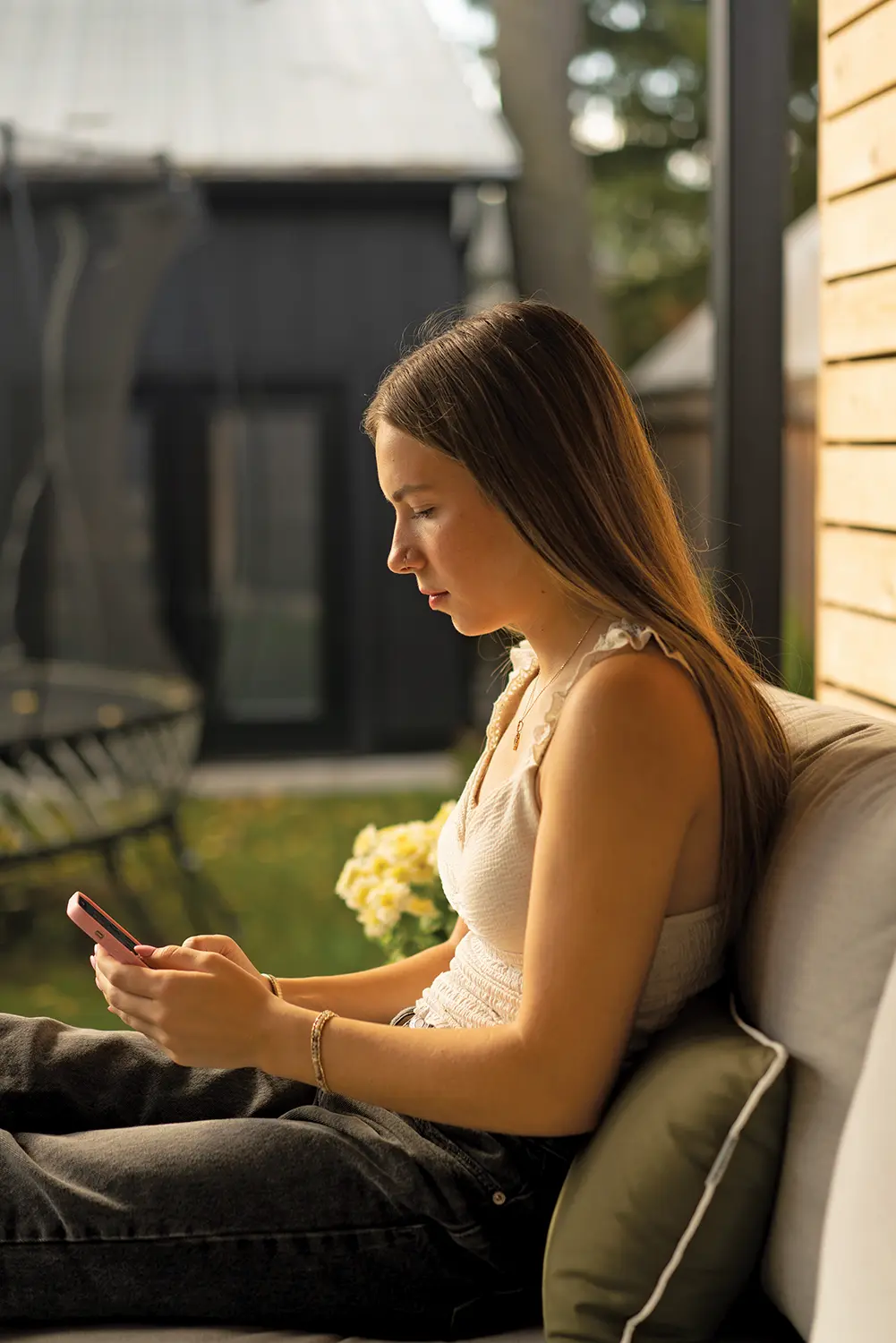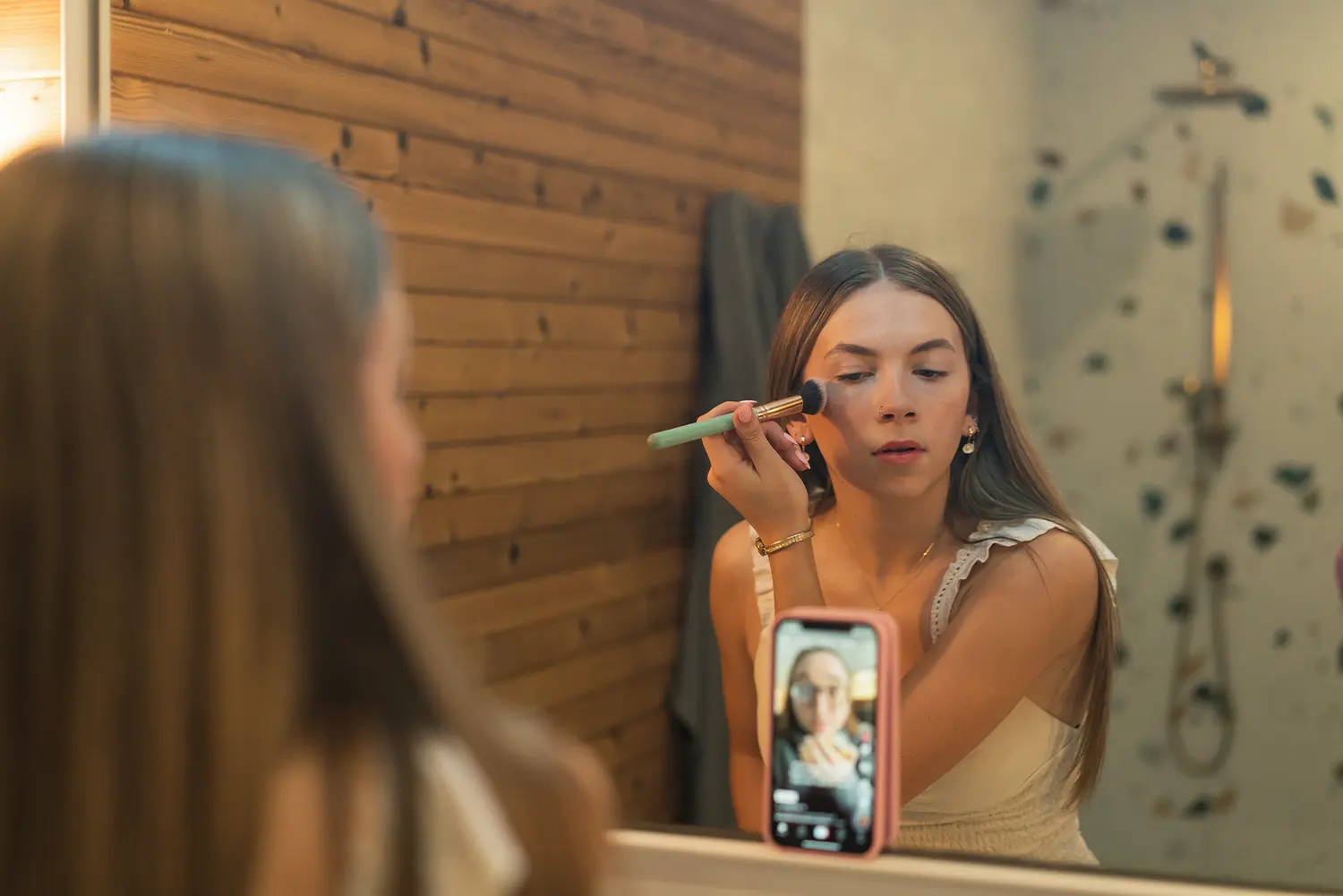The toll of screens on kids is becoming increasingly clear, but there’s hope when parents and educators tackle the issue head-on.
by Jessica Wortsman // Photography by Jessica Crandlemire
Remember when childhood meant riding bikes around the neighbourhood and playing outside with the kids on the street until sundown? Our parents didn’t know exactly where we were but trusted we’d be home for dinner. Remember crowding onto a couch together to watch a movie, all eyes on the same screen? It all seems impossibly quaint now.
Childhood has changed. Kids still hang out together but look mostly at the phones in their hands. They still ride bikes but rarely without a parent tracking or checking in with them. They have little independence in the real world and unrestricted access to the online one.
This has done something to our children. They are more anxious, more depressed, and lonelier than ever before, and rates of eating disorders, self-harm and suicide are up. Many are calling it an epidemic of teen mental illness, and while the cause is complex, there is now mounting evidence that points directly to smartphone and social media use.
It’s a sad, scary situation that some feel is a lost cause, but others are certain can be turned around through collective action and a hefty measure of parental fortitude.

The kids are not all right
In his most recent book, The Anxious Generation, social psychologist Jonathan Haidt explains how the shift from a play-based childhood to a screen-based one has “rewired” children’s brains. He argues that increased time spent on screens, particularly smartphones, and decreased time spent engaging in real world activities, has resulted in a sharp and steady decline in kids’ mental and emotional well-being.
children’s brains are being impacted by digital media use, both directly and indirectly. From increased impulsivity, aggression and dopamine levels, to decreased focus, cognition and brain volume. The link between social media use and sleep deprivation alone can account for changes to mood, behaviour and the brain’s ability to think and focus.
Gwen Jamieson, a registered social worker working with youth, adults and families in Collingwood, says she’s noticed similar trends in her clients in recent years. “We are seeing a lot more insomnia, anxiety, struggle with attention span, difficulty in regulating or self-soothing, and we saw eating disorders skyrocket.” She cites several factors, including the pandemic, but believes excessive screen time and inappropriate online content have played a significant role.
Missing out on life
Haidt calls smartphones “experience blockers” because time spent on a phone is time not spent doing something in real life. Based on current stats, kids spend an average of six to nine hours daily looking at a screen, be it a smartphone, tablet, computer or TV. The opportunity cost is massive. Those are hours they aren’t spending playing, exploring, exercising, connecting, working, reading, creating, being bored, or even simply just looking at the world around them.
Consequently, says Katherine Johnson Martinko, a journalist and author of Childhood Unplugged: Practical Advice to Get Kids Off Screens and Find Balance, kids are not learning skills that are going to serve them well in the future, like making eye contact and conversation, or allowing themselves the solitude and silence necessary to think and have ideas of their own. Their minds are constantly inundated with superficial stimuli instead of high-quality inputs. Like a junk-food diet for the brain.
“I just think kids need to spend more time thinking about things,” Martinko says. “That’s how creativity is spawned.”
Sure, smartphones can be used for creative pursuits, like exploring other cities through Google Maps, editing videos with CapCut, or even downloading ebooks from the local library. But let’s be real, that’s not what most kids are doing on their phones. What they are doing is passively absorbing content, content that is often troubling. According to Statistics Canada, MediaSmarts, and the RCMP, over 70 percent of
Canadian youth encounter online hate, with more than half regularly exposed to racist and sexist content. While nearly a quarter admit to seeking online pornography, a third have stumbled upon it unexpectedly. Perhaps most concerning is their exposure to “cybervictimization,” with a quarter of Canadian kids experiencing cyberbullying, and sextortion cases skyrocketing by 88 percent in the last year alone.
“The main thing is the human connection. The phone is more interesting than the person beside them. The conversation has to beat whatever’s on the phone so it’s like, how good can this conversation get for you to take your eyes off your phone?”
Zoe Moffat-Lynch, 17

“We are seeing a lot more insomnia, anxiety, struggle with attention span, difficulty in regulating or self-soothing, and we saw eating disorders skyrocket.”
Gwen Jamieson
Tough on teachers
Nowhere have cell phones wreaked more havoc than in the classroom. They’re not just a constant distraction; they’ve facilitated cheating and fueled a rise of cyberbullying.
It’s been exasperating, say two public high school teachers in the Southern Georgian Bay region, each with over 20 years of experience. We provided them anonymity so they could speak more freely.
“We want to be teachers, and the students want to be students,” says teacher A. “We don’t want to be the phone police. And we are. It’s constant. You’re trying to teach something and it’s just ‘Put your phone away. Put your phone away. Put your phone away.’”
Teacher B says that in a typical 75-minute class, it was not uncommon for her to issue phone reminders about once every minute. The academic impact has been huge. “There’s a high level of distraction and there’s a huge decrease in skills,” she says. Books usually taught in Grade 9 are now being taught in grades 11 and 12.
It’s no wonder. A 2023 UNESCO report found that even the proximity of a smartphone (say, in a pocket or backpack) could distract a student in class, and that once distracted, it could take up to 20 minutes for the student to refocus. Multiply that by a phone distraction every minute and the result is grim.
Phones out, focus in
Fortunately, there has been a global push to restrict cell phones in classrooms, with regions in countries like France, Italy, England and Australia going so far as to ban them from schools completely, even in secondary schools.
The Ontario Ministry of Education has implemented a new cell phone policy for the 2024/25 school year as well. It requires cell phones to be turned off or on silent and out of sight during class time for students in grades 7 through 12, and throughout the entirety of the school day for kindergarten through Grade 6. Many worried the policy still allowed phones to be brought to class and kept in pockets and was identical to the unsuccessful “off and away” policy already in place in most schools.
When asked how this new policy differs, Collingwood Collegiate Institute (CCI) principal Kelly Lalonde says it’s the provincial backing that will be key to ensuring stricter enforcement, with each school deciding how to best implement it.
Speaking on CCI’s enforcement plan, Lalonde says, “I can speak for our school that it’s heavily based on communication and working with parents in order to make sure students understand the expectations of the classroom.” While phones won’t be confiscated, parents will be contacted if one is used without permission. She says they’ve received great feedback so far from teachers, students and families.
But banning cell phones from class highlights another concern. “Just because the government makes an announcement,” says teacher A, “doesn’t mean it’s magically going to be fixed.” Policies aren’t enough, he says. Schools need plans but they also need funding. “We have Chromebooks at the school but a lot of times, they don’t work or the Wi-Fi’s not working.”
“It’s not uncommon,” adds teacher B, “for you to have a class of 30 and only 11 Chromebooks that are working.” It’s an issue she’s already dealing with again this school year and worries it sends a mixed message. How can you ban phones without providing adequate alternate technology for the students?
Despite the technology shortage, teacher B says these phone restrictions are long overdue, and she’s already seen positive changes in her school this year. “It’s a really good start,” she says, citing an unprecedented amount of communication about the phone policy between administration, staff, families and students, along with teacher support materials and a strict enforcement plan too, one that relies less on teachers and more on parental involvement.
Teacher B says her students seem happy with the change and so far have been respecting the policy. “It’s almost like they wanted it. Even if they didn’t know they wanted it, they wanted it.”

Where to begin?
Parenting in the age of smartphones and social media has been rough. The lack of guidelines, fear of causing social isolation, pressure to conform, and the challenge of keeping up with new apps and features has left most parents struggling to find their footing. They worry their kids spend too much time on screens but aren’t sure what to do about it.
Collingwood dad James McCrimmon says his two kids, aged 15 and 16, are tethered to their phones when not in school or playing sports. They’re tech-savvy too, so screen time limits are easily circumvented. While he enjoys being able to keep in touch with his teens while they’re out and about, he does worry what all that screen time is doing to their brain development, eyesight and self-esteem. But it’s what they’re missing out on that worries McCrimmon most. “Life, period. Just life. They’re missing out on life,” he says.
A good place to start, suggests journalist Martinko, is with digital minimalism. The concept, coined by computer science professor and author Cal Newport, is a philosophy of intentional technology use. It’s about limiting your digital activities to only those that add the most value to your life. For Martinko and her Port Elgin family of five, that means screens are only used when necessary for work and school, and the occasional family movie. None of her kids have cell phones or social media, not even her teenager, who uses the family computer to message friends. Instead, they are encouraged to engage in real-world activities that promote creativity, responsibility and independence, like picking up groceries for dinner or walking their neighbour’s dog. And far from having stunted their social lives (as many parents fear), she says her kids are always busy with friends doing things like riding bikes, playing basketball, and hanging out in the backyard.
You know, kid stuff.
It’s the kind of childhood Haidt champions. Less screen time, more play time, especially with other kids, and lots of independence.
In her own effort to unplug, Jennifer Greco relocated with her 11-year-old son from Newmarket to quieter Midhurst. “That transition was so that we could push him outside and he would have free play on the street, because I feel like that’s the thing that the phone has replaced,” she explains. It’s been a wonderful change, she says. “It was something that we were missing. All the kids in Newmarket would just go inside and be on their computer.”
It’s not enough to just cut back on screen time either; you have to fill the void, says Martinko, who shares tips for weaning families off devices and revitalizing the home environment in her Substack newsletter The Analog Family. “You need to help your kid build a life that they don’t want to escape from. Give them things to look forward to.”
Embrace boundaries
Setting boundaries is challenging, especially with teenagers, and for those parents who may have resented having them as children, but they are crucial. Without boundaries, Martinko warns, you end up with a child that feels lost.
“It’s hard, it’s absolutely hard,” she says of setting screen time boundaries. “Even for me, with my somewhat no-nonsense approach…but it’s the one job that we have to do for just these few years.”
Parents need to examine their own screen time habits too, she says. “If you tell your teenager to rein it in, you absolutely have to model that behaviour as well.” In other words, you’ve got to walk the talk.
It’s also important to talk to your kids about their screen use and online activity, says the Collingwood social worker Jamieson, no matter how uncomfortable or difficult it can be. “We tend to avoid those hard conversations because we want to avoid conflict, but those are really important conversations to have.”
Avoid overreacting and instead get curious, Jamieson says. Ask them questions about how what they see online makes them feel about themselves, and about their reasons for posting content. Are they seeking reassurance, validation, making comparisons, or simply highlighting memories?
Time for action
Technology is a fantastic tool, but somehow, we’ve let it take over childhood. Our children are spending their formative years online rather than living in the real world and the consequences have been dire. But parents everywhere are beginning to take action. Some are writing to their school administrators demanding a bell-to-bell policy where phones are locked away for the entire school day. Others are rallying their communities to make pledges, like the Wait Until 8th pledge to delay giving their kids a smartphone until at least the end of Grade 8, and even longer for access to social media. It’s not too late to fix this, if we do it together. It takes a village, right?

“If you tell your teenager to rein it in, you absolutely have to model that behaviour as well.”
Katherine Johnson Martinko
The Science Explained
Blue Light: Screens emit blue light, which interferes with the production of melatonin, the hormone that regulates sleep. Children and teens are more sensitive to the effects of blue light because of their larger pupils and clearer ocular lenses. Dozens of studies have found that children’s exposure to screens before bed has led to later bedtimes, fewer hours of sleep and poorer sleep quality.
Dopamine: Studies show that screen use (particularly social media, video games and video streaming) floods the brain with the neurotransmitter dopamine, giving kids a quick hit of pleasure that keeps them coming back for more. This can lead to dependency, trouble with impulse control, aggression and motivation.
Brain Development: Excessive screen use has been shown to thin the frontal cortex and reduce both grey and white brain matter volume in children, which can impact their thinking, decision-making and emotional regulation.
Resources
Wait Until 8th
waituntil8th.org
The Analog Family
katherinemartinko.substack.com
Let Grow
letgrow.org
Screen Strong
screenstrong.org












